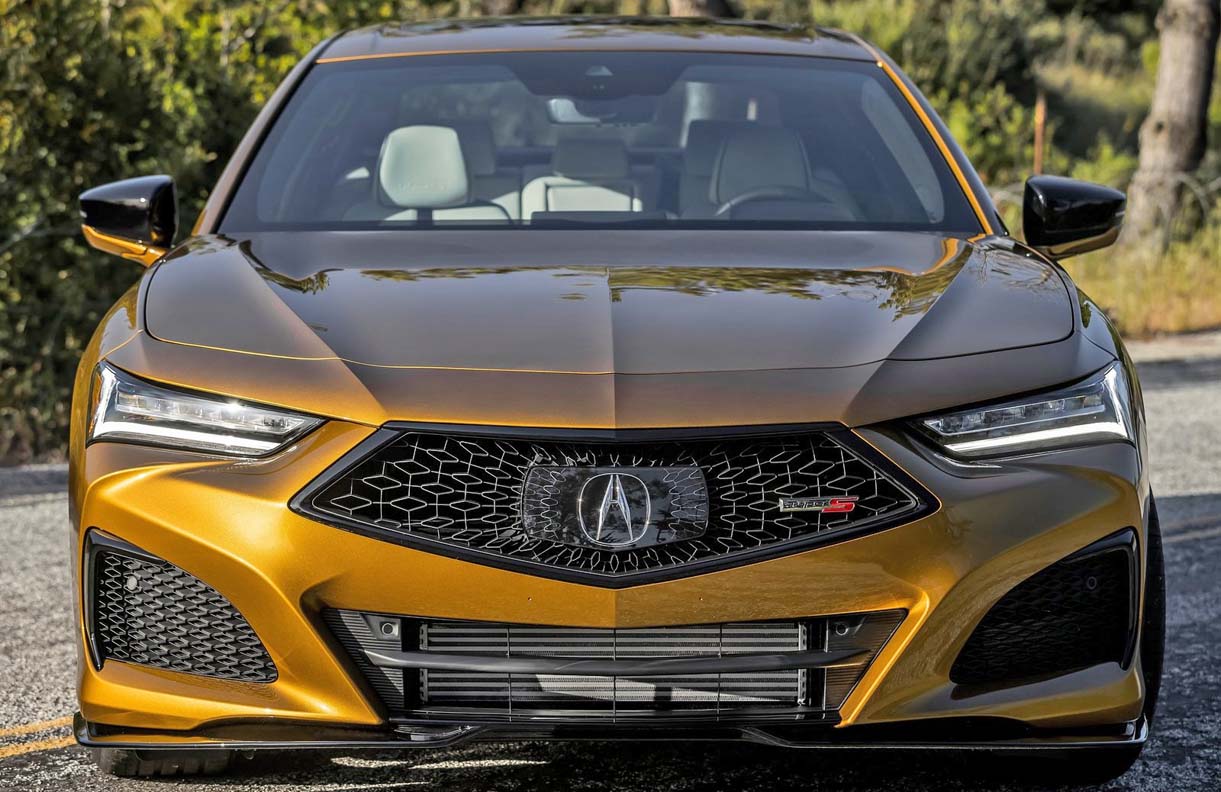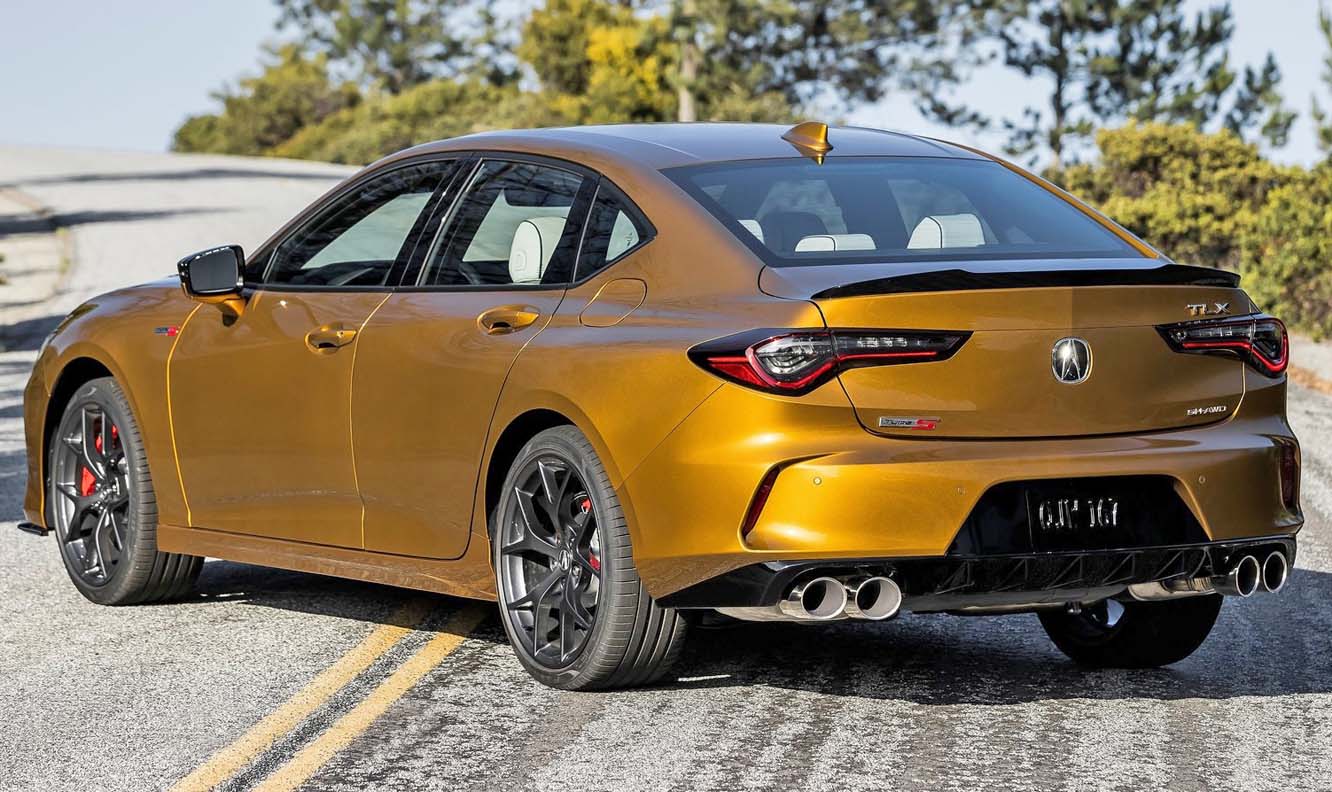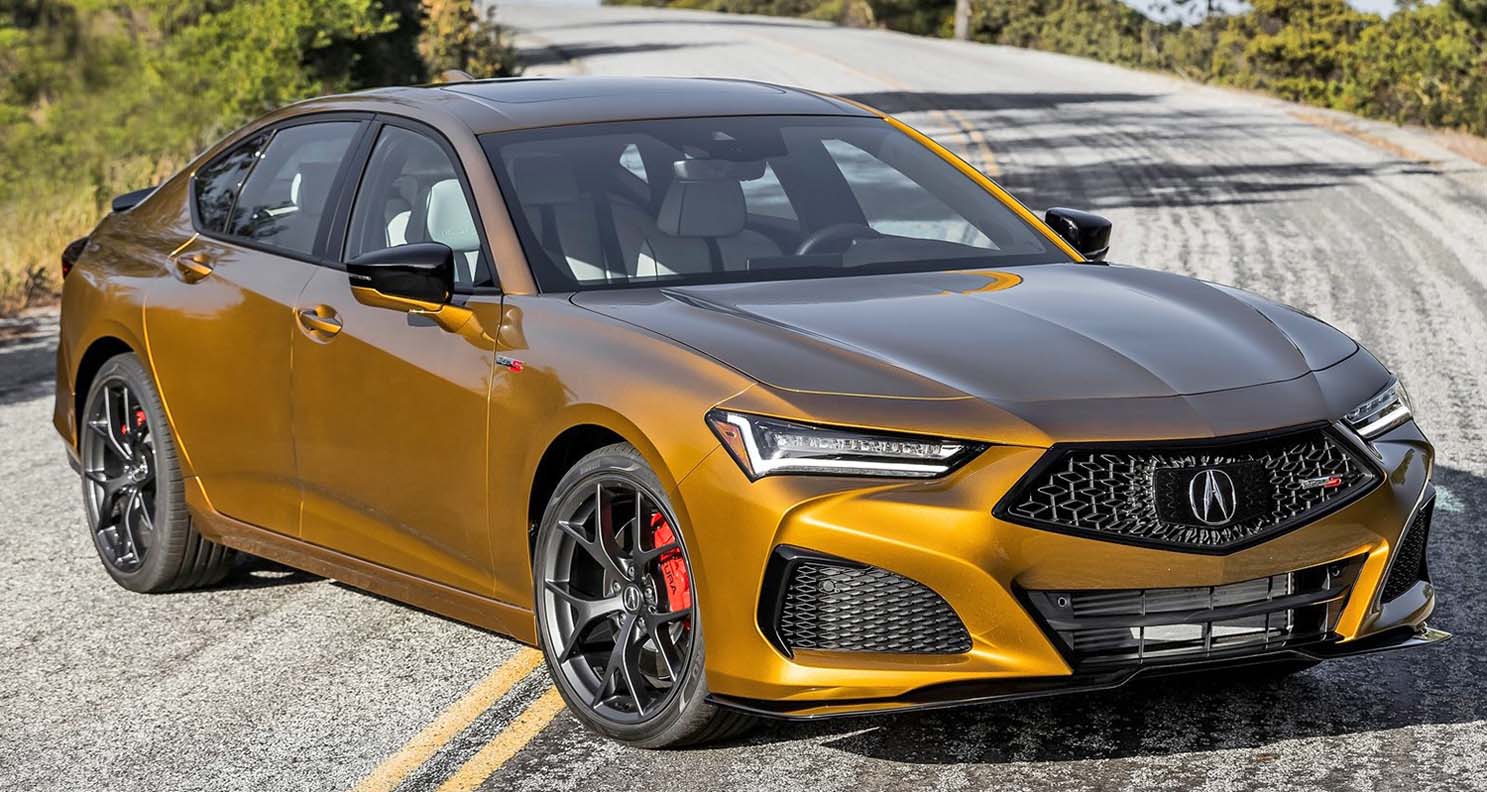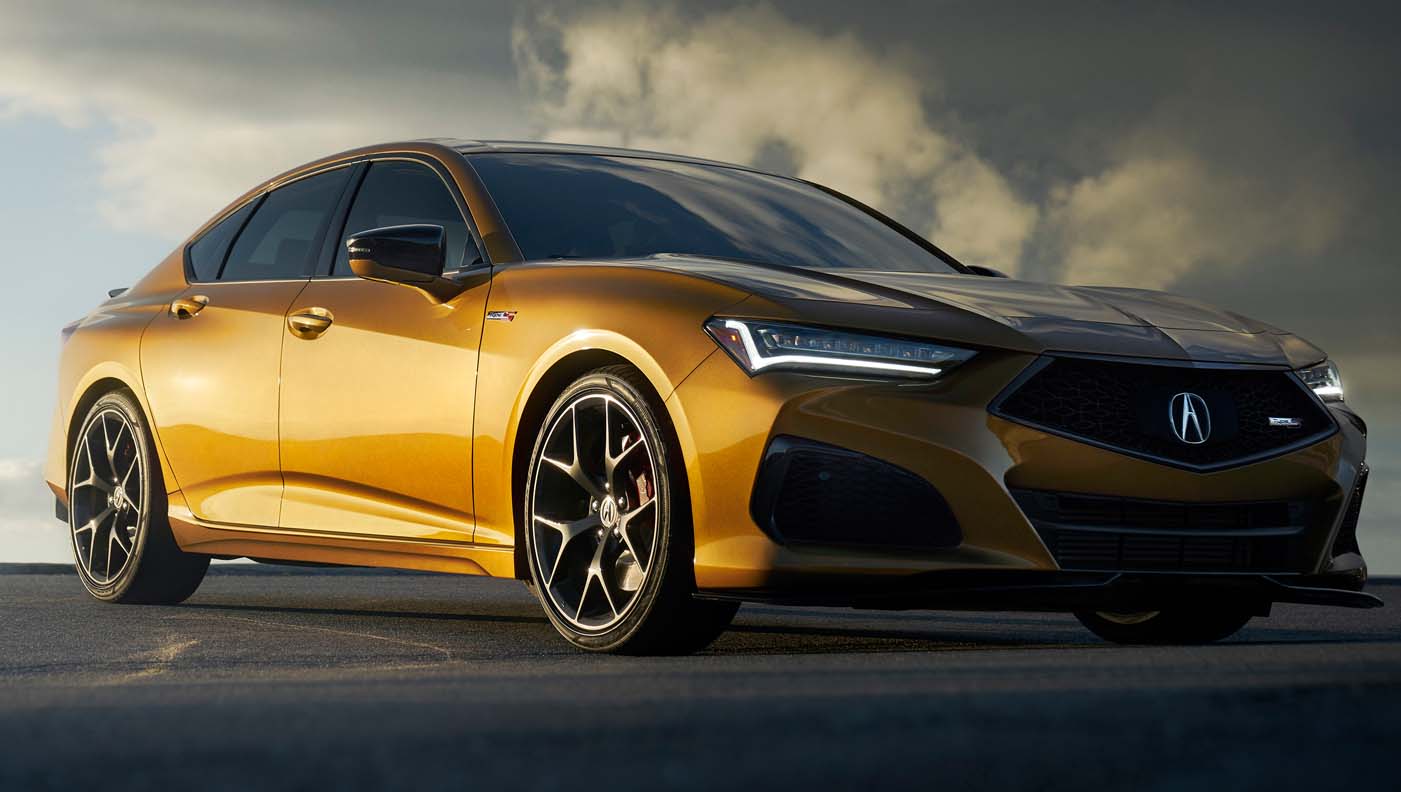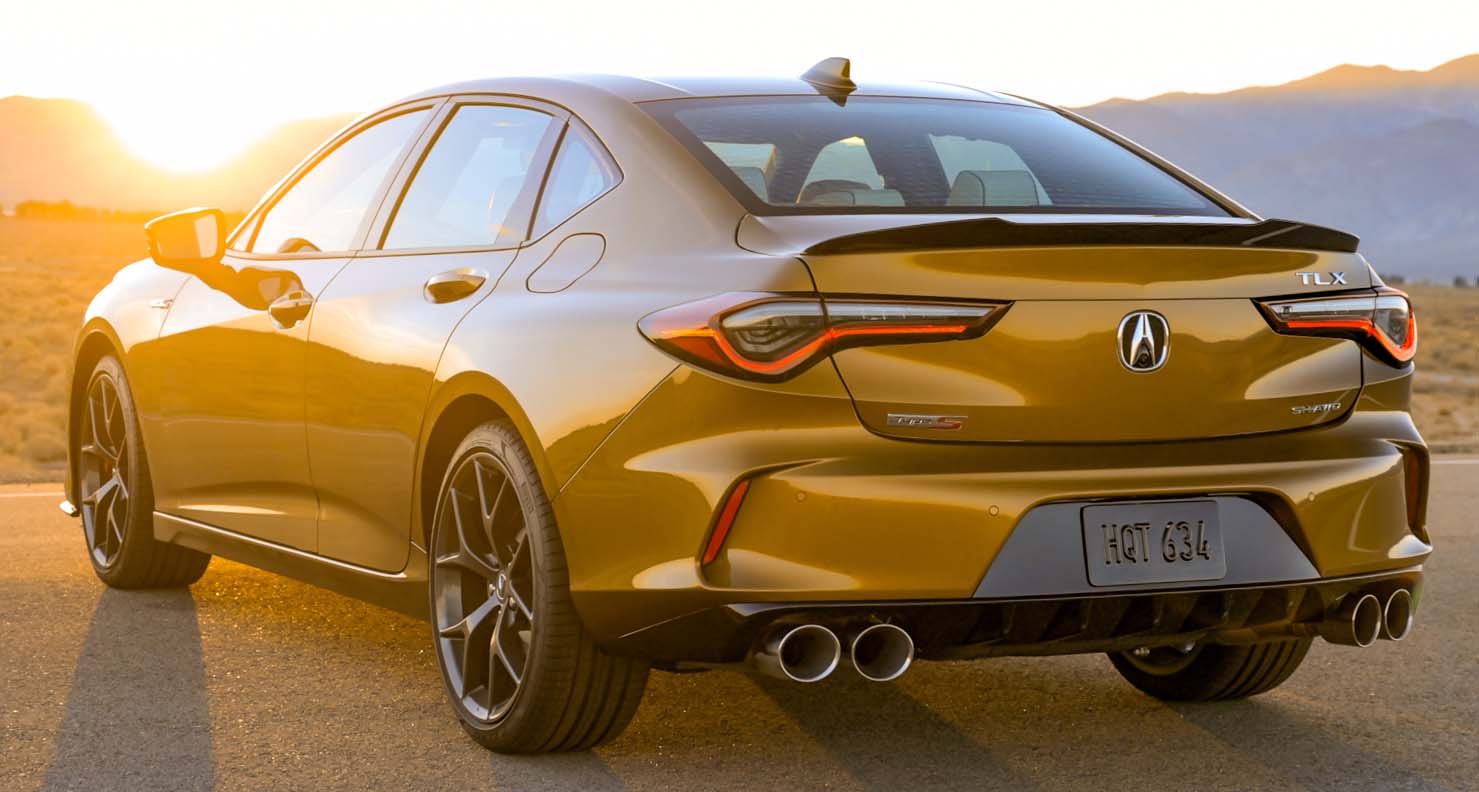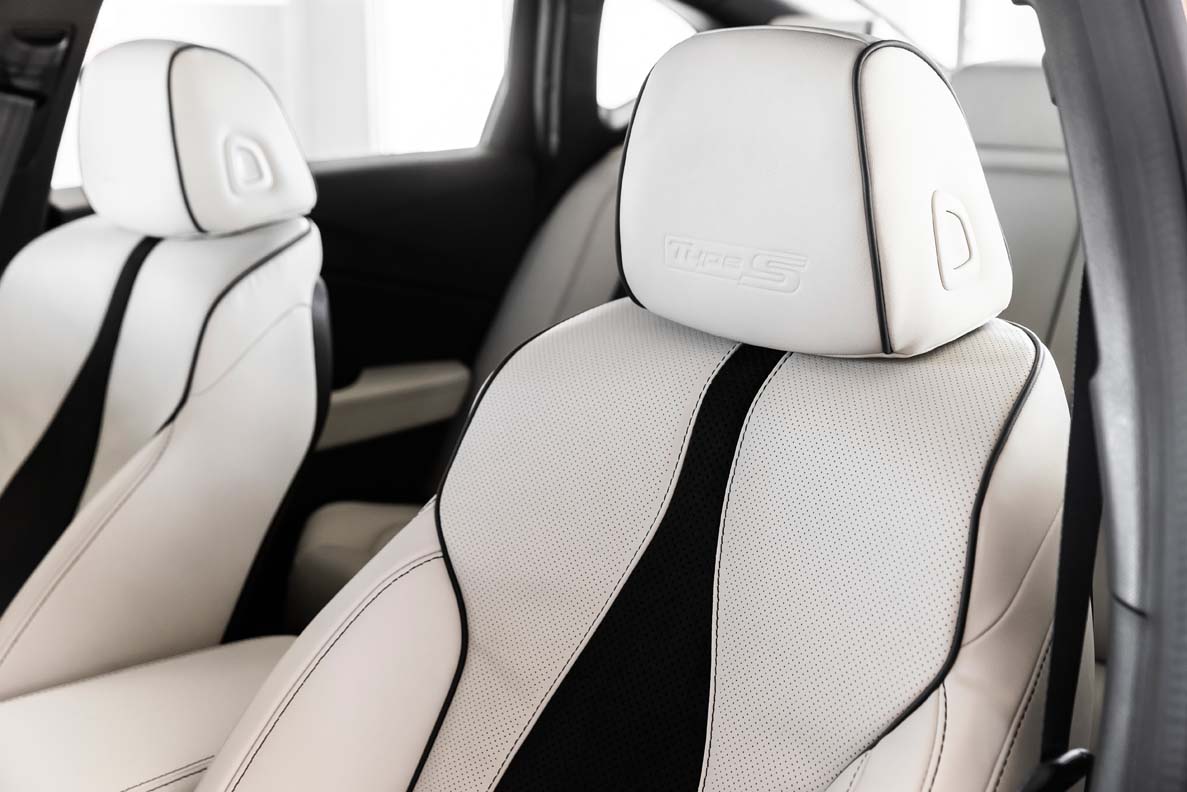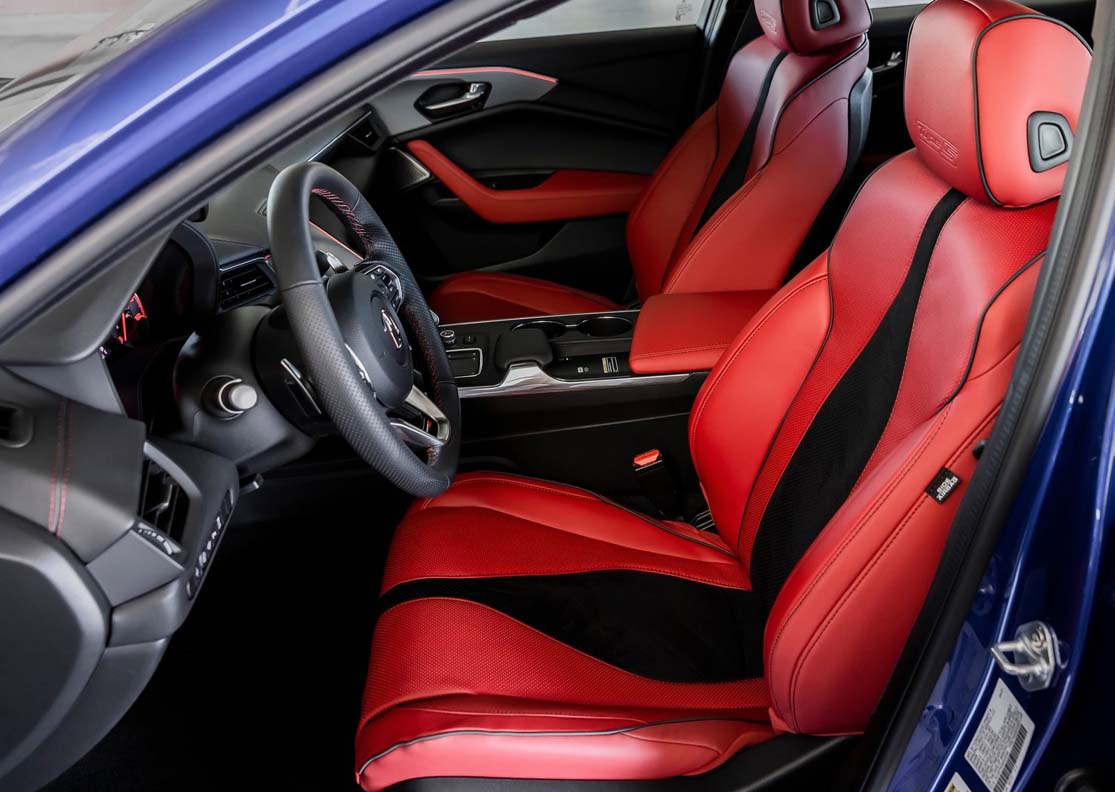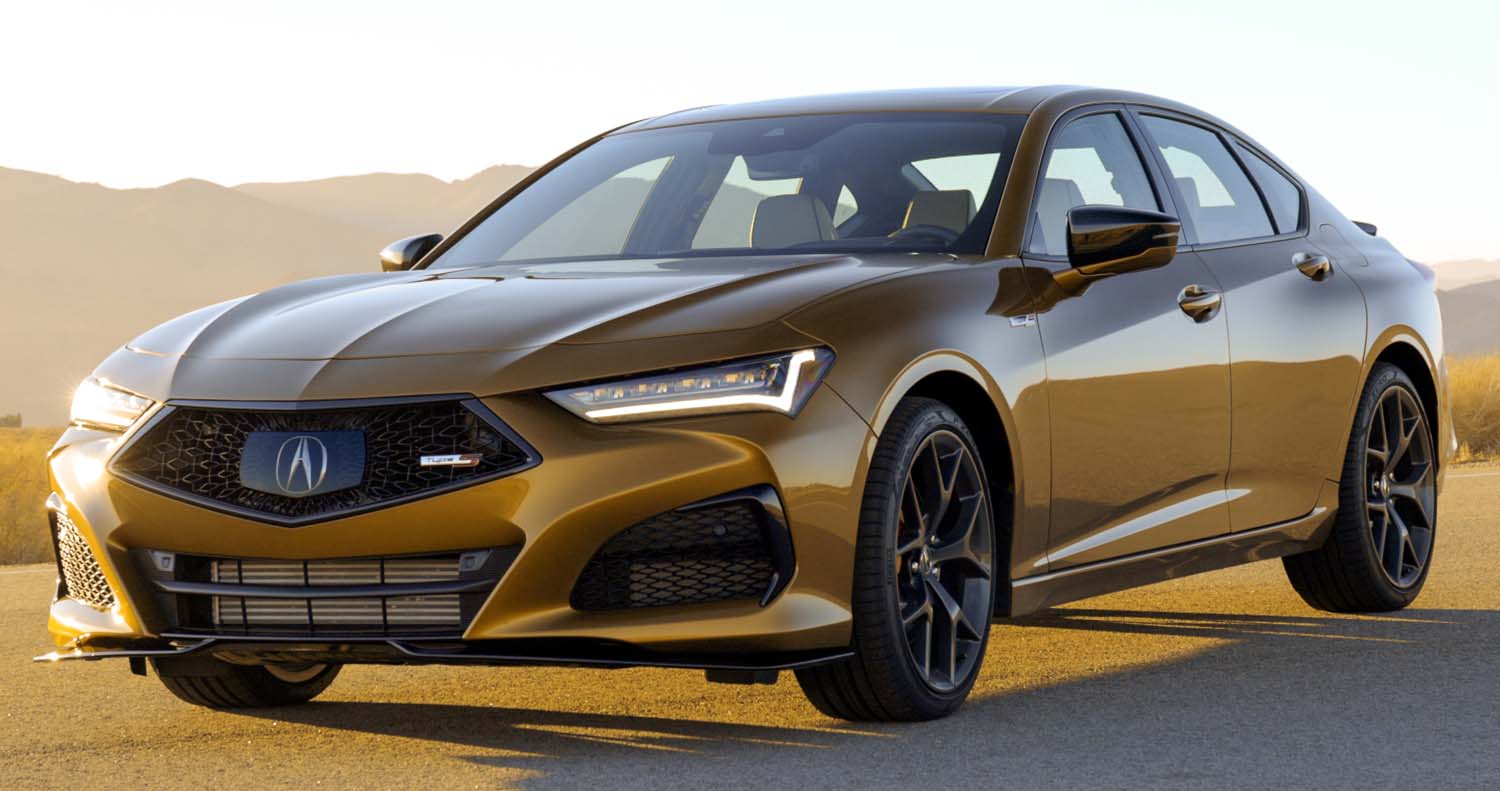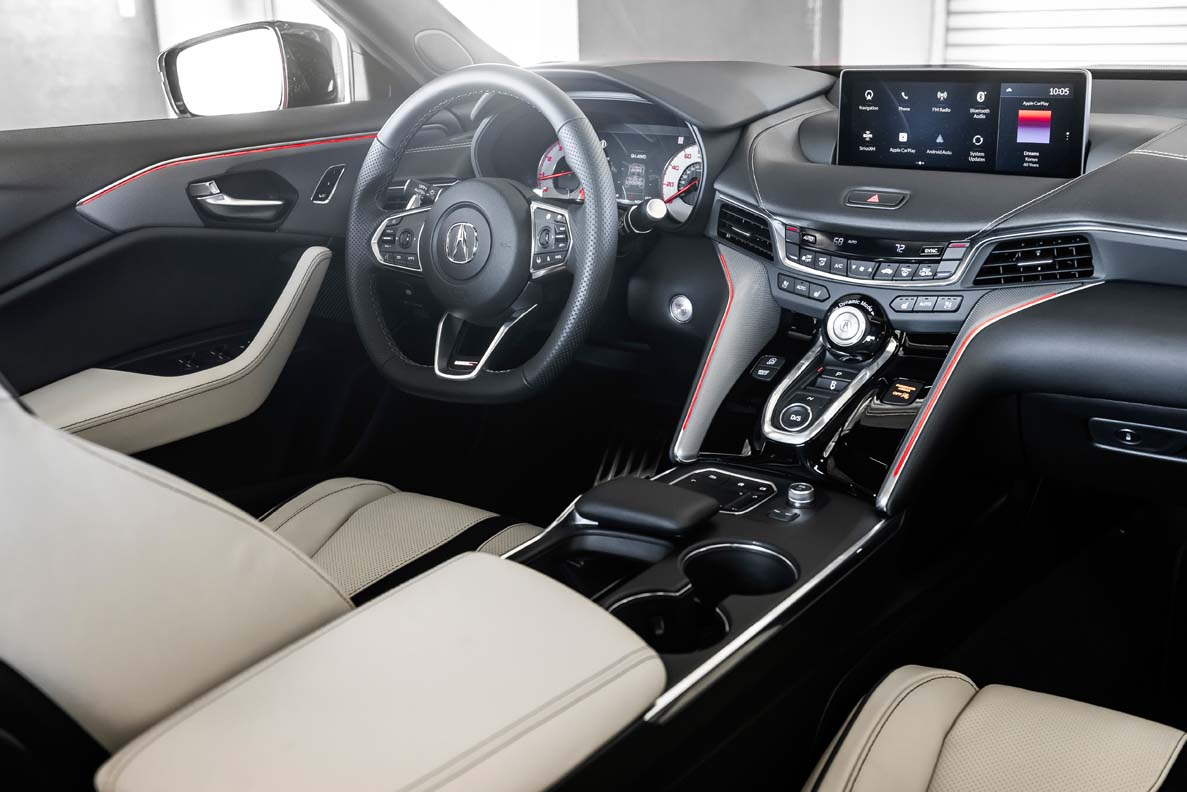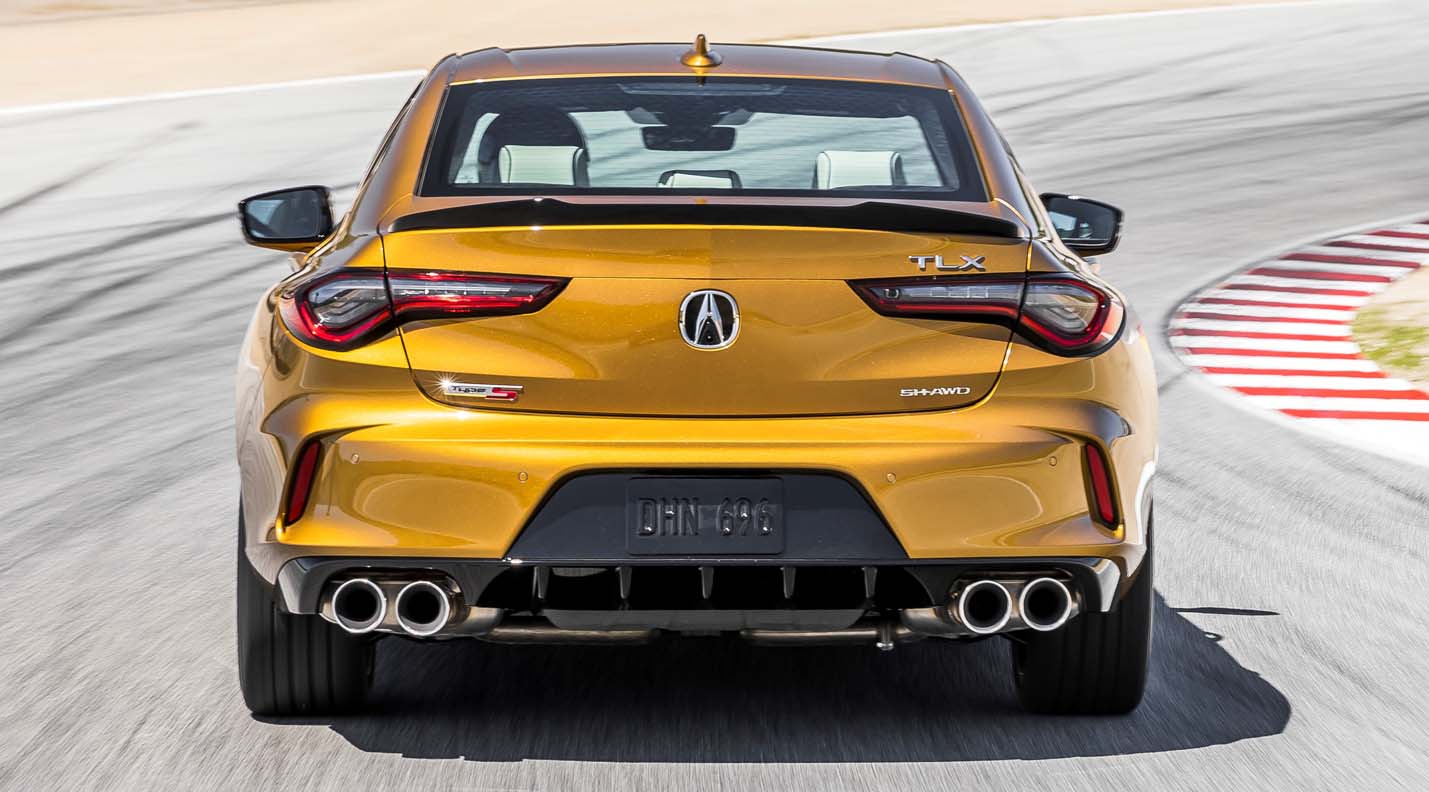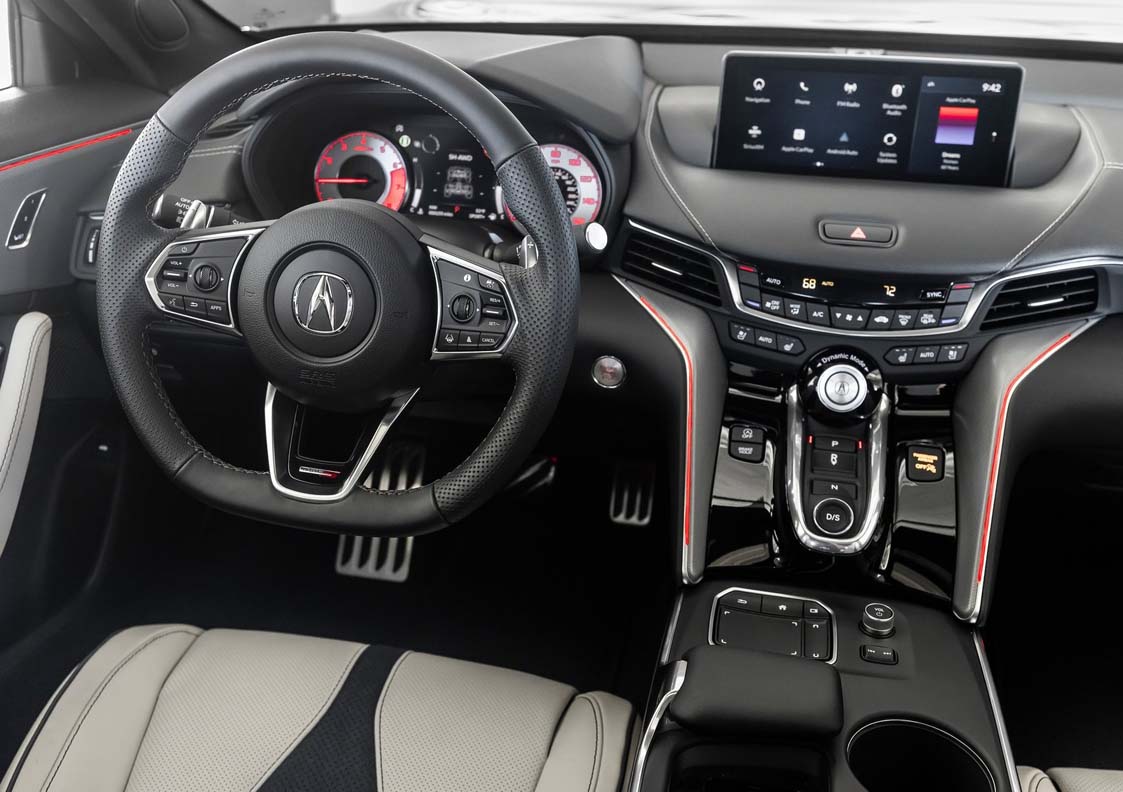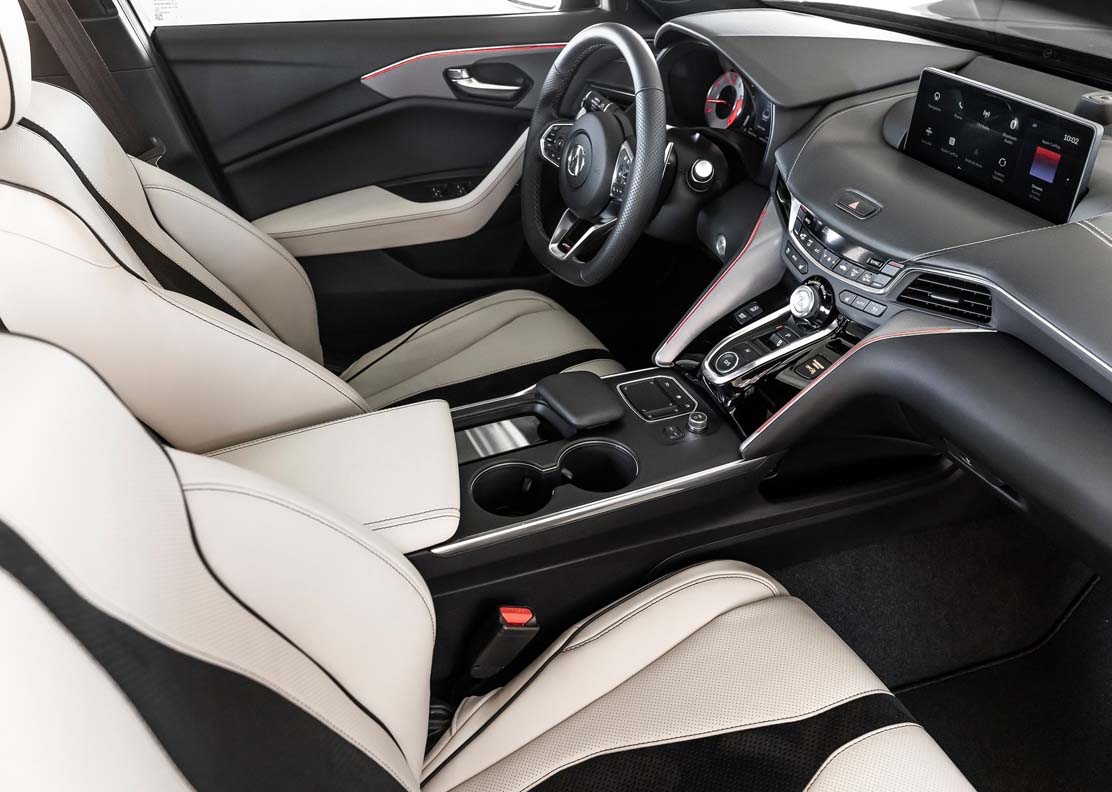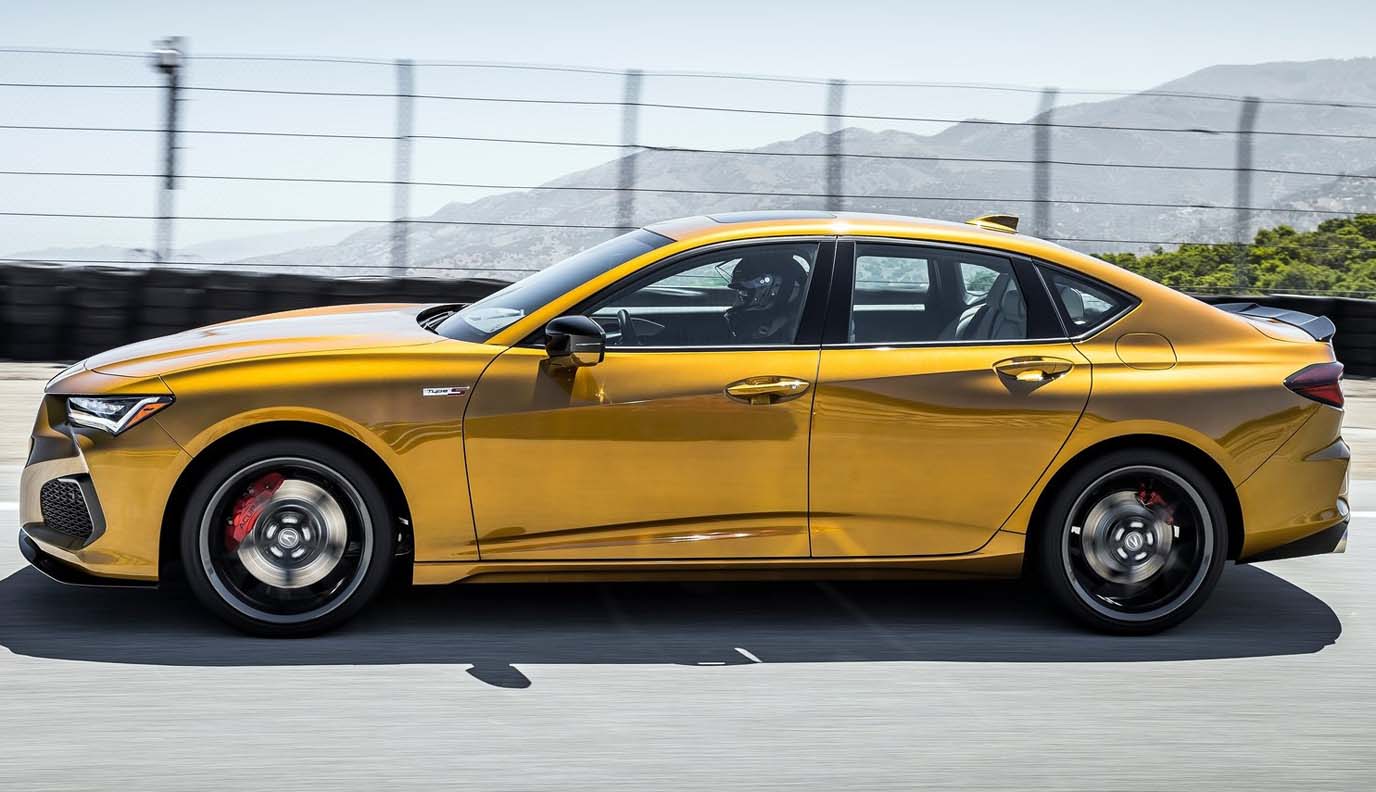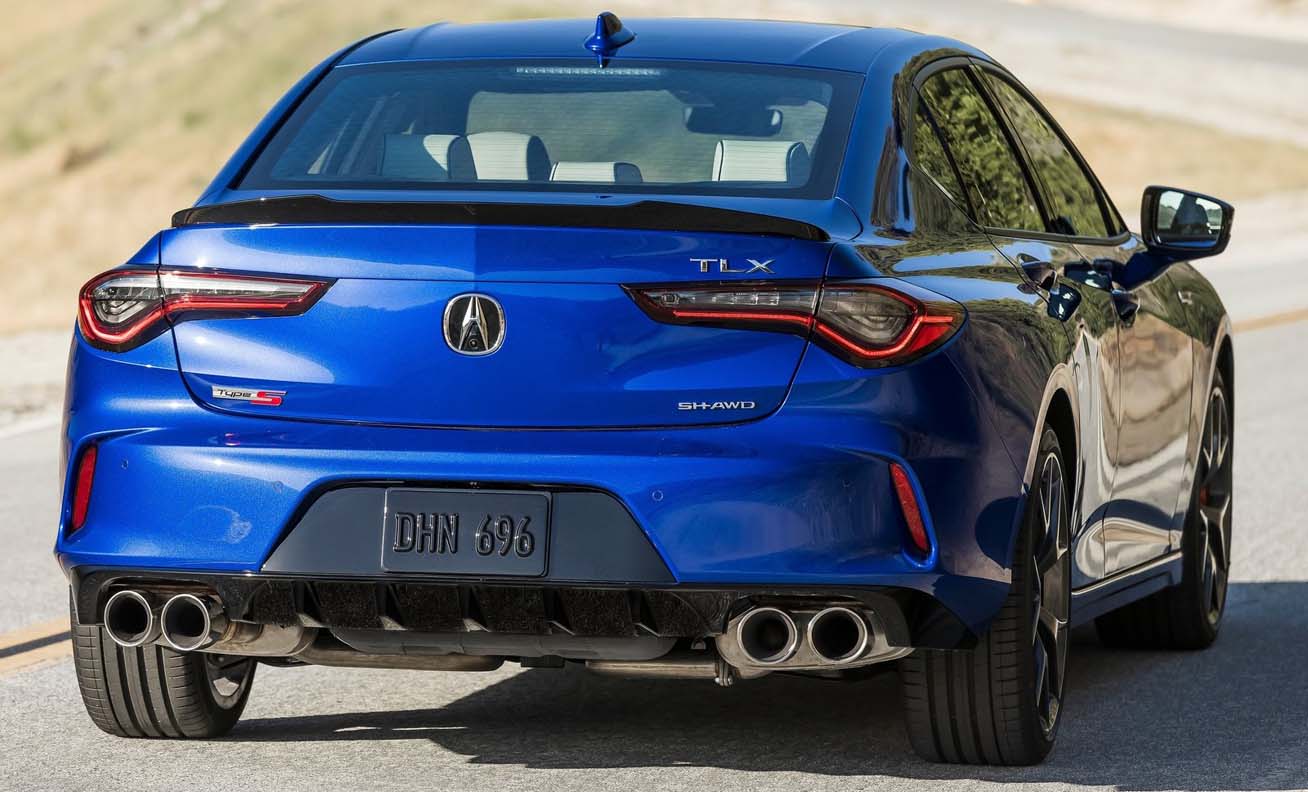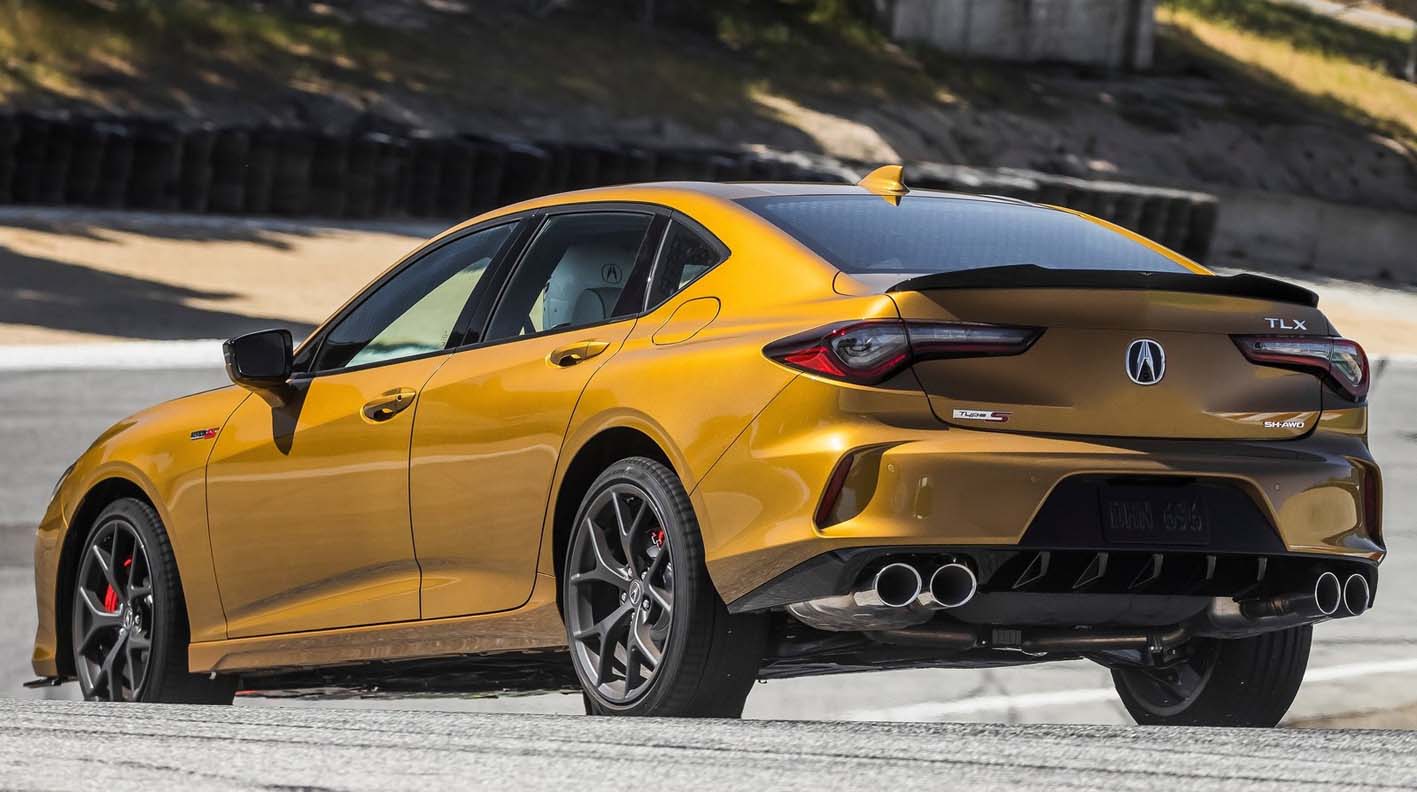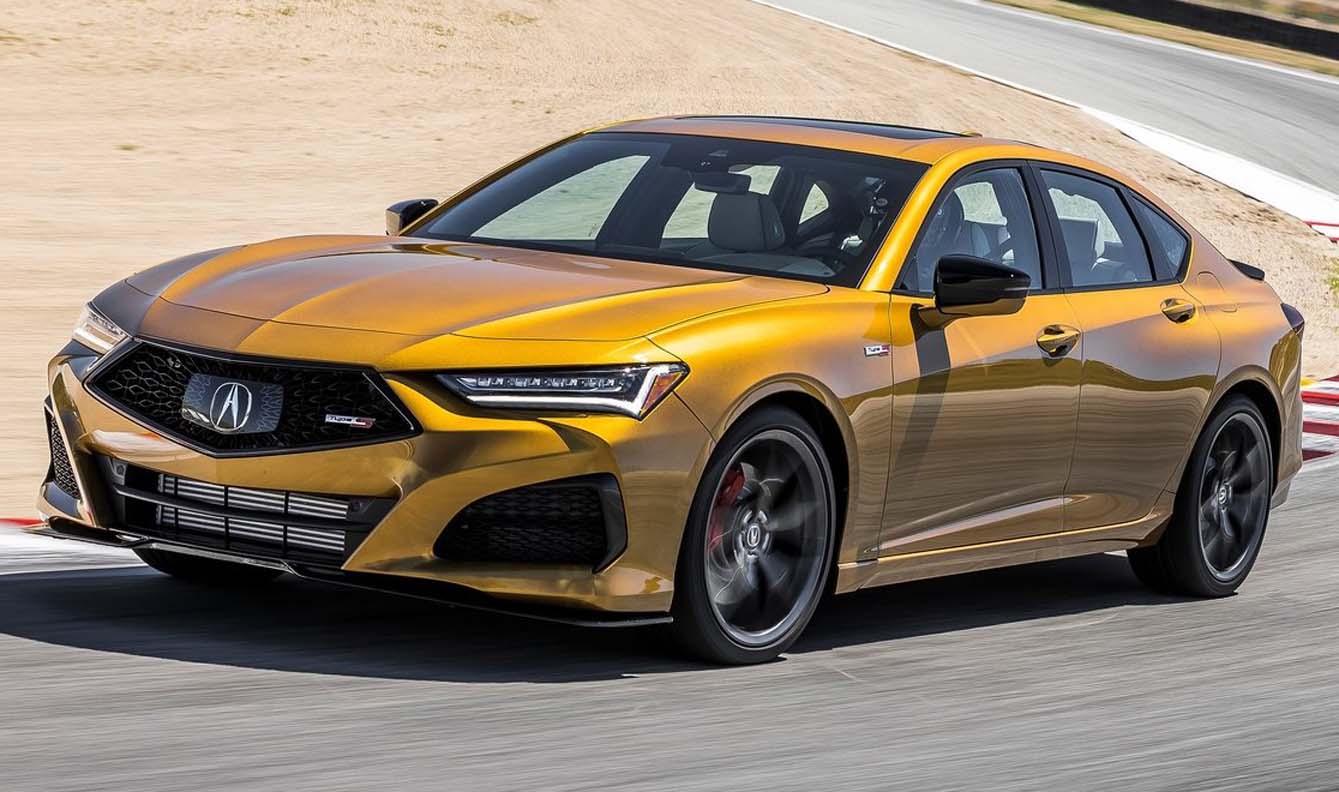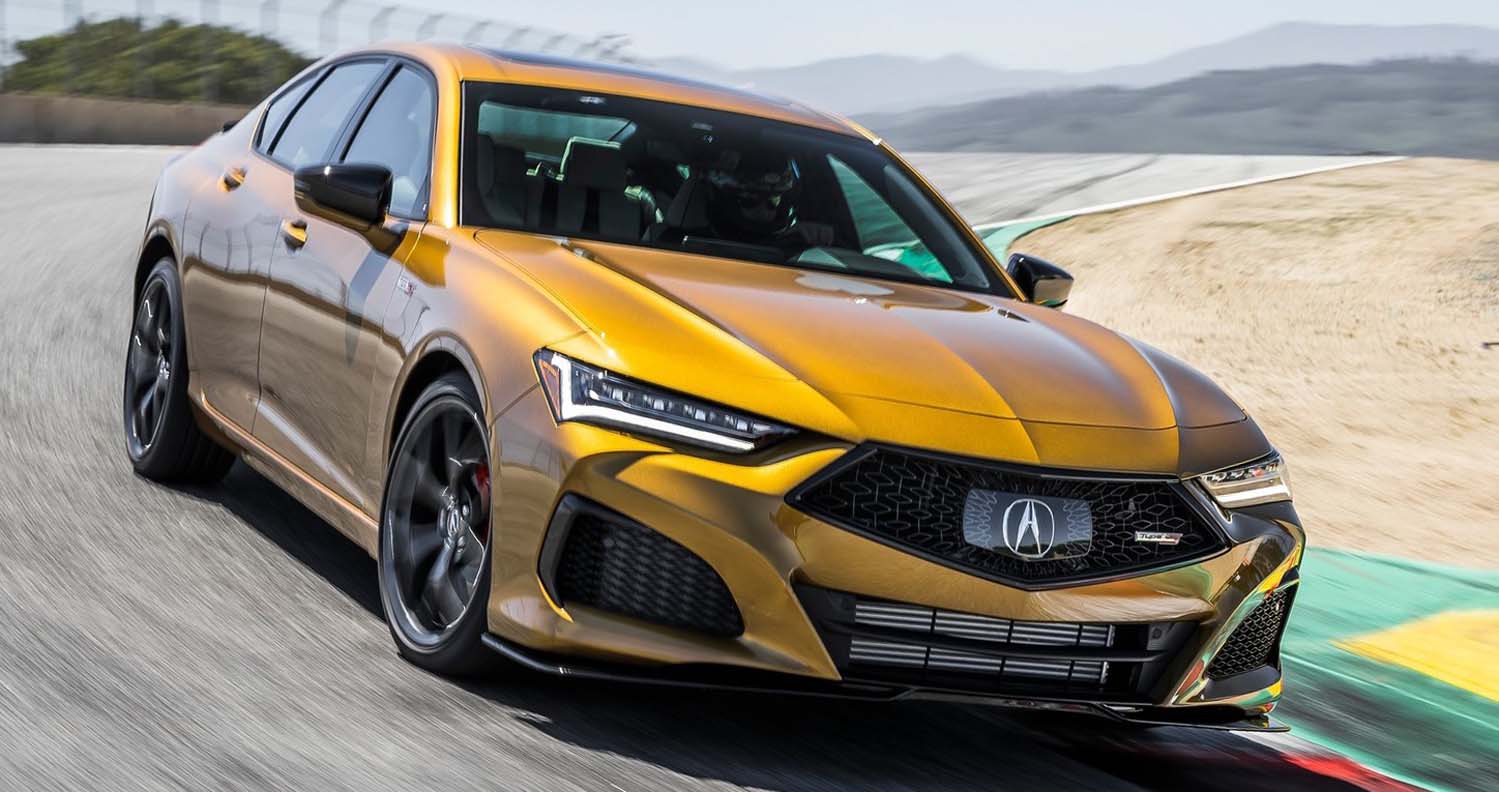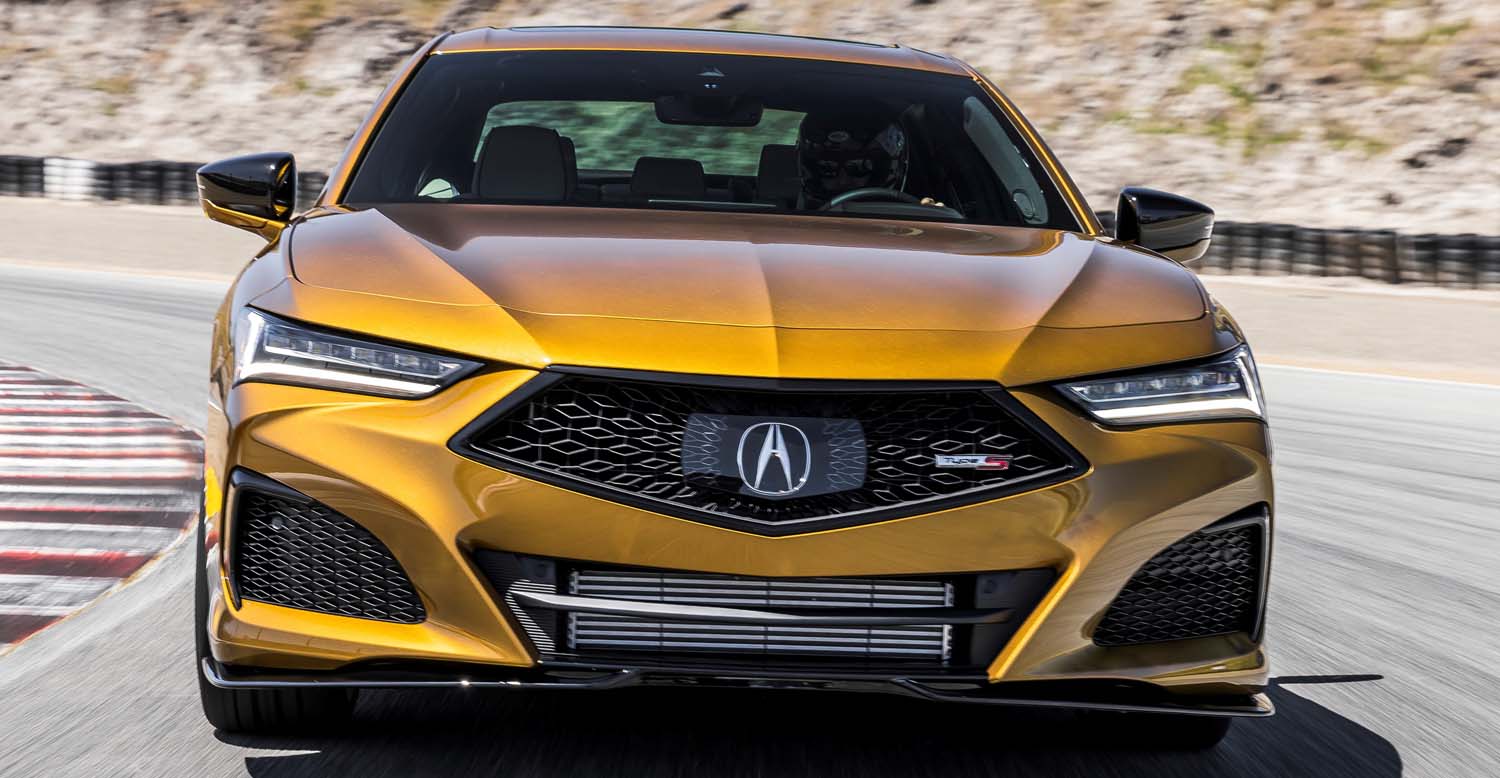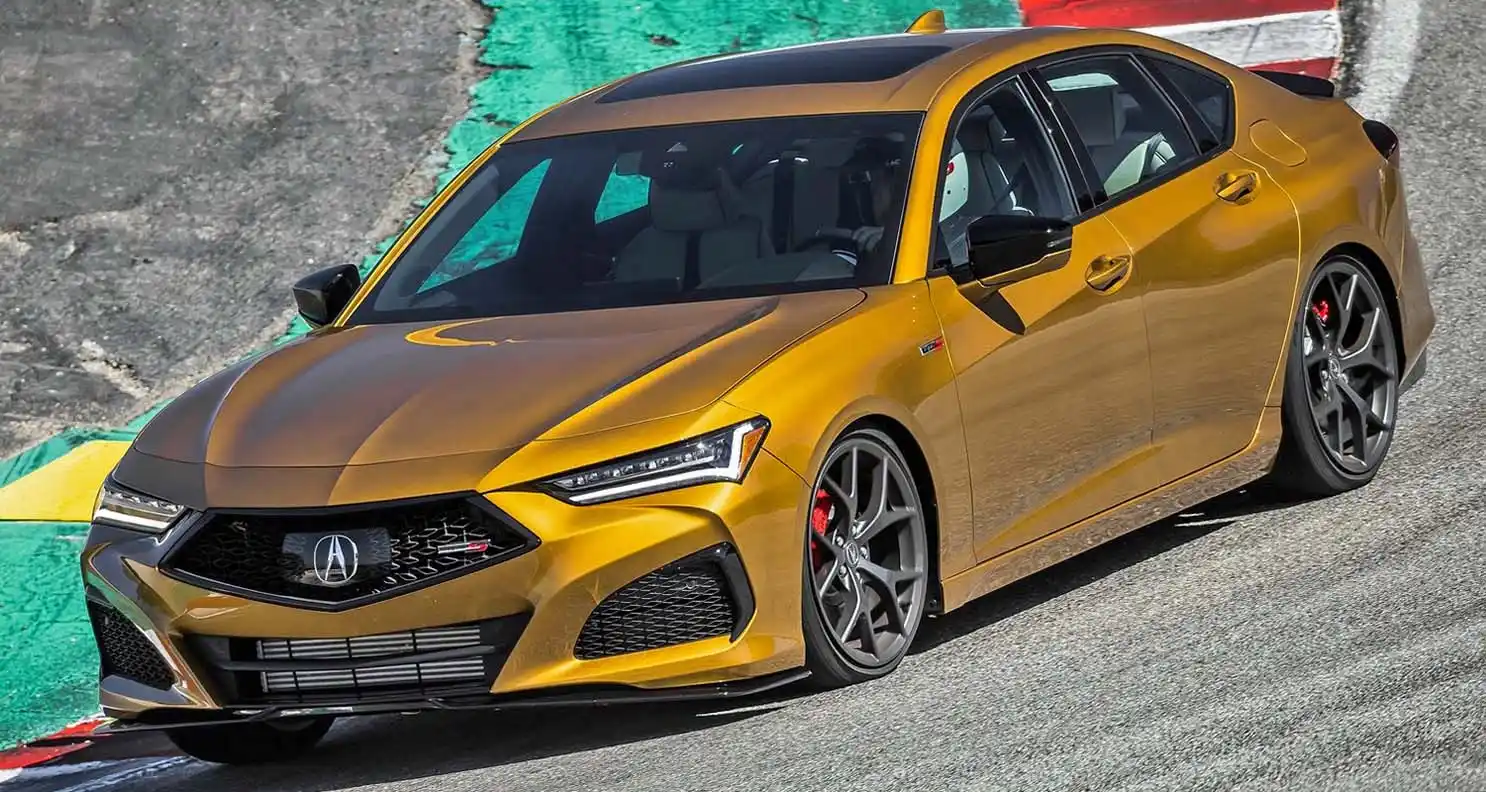
For the first time in more than a decade, Type S returns to Acura showrooms with the debut of the 2021 Acura TLX Type S, simply the best performing sedan in Acura history. The new TLX Type S is powered by the Type S Turbo V6, a new Acura-exclusive 355-horsepower turbocharged 3.0-liter engine. It also features a specially tuned double-wishbone front and multilink rear suspension, Brembo® front brakes and new Sport+ driving mode for the Integrated Dynamics System.
Previously available on select models from the 2001-2008 model years, Acura’s Type S performance brand is recognized by driving enthusiasts seeking a more dynamic driving experience with additional power, improved handling and stronger braking. The 2021 TLX Type S pushes this philosophy to new heights and will be followed by the first-ever Acura MDX Type S.
Previewed by the Type S Concept in 2019, Acura’s engineers have created an emotional and exciting premium performance sedan without sacrificing the everyday usability and comfort of the critically acclaimed second-generation TLX. The new Acura TLX Type S is about 25-percent quicker to 60 mph than the standard TLX with a 0-60 time around 5 seconds and has a significantly higher top speed, increasing from 130 mph to 155 mph (electronically limited). Braking performance is also improved and with standard SH-AWDÒ with torque vectoring, 20-inch wheels and available summer tires, it’s the best performing Acura sedan ever.
TLX Type S is instantly recognizable by its open-surface Diamond Pentagon grille that improves engine cooling, quad exhaust outlets, a front splitter and rear diffuser. Its driver-focused interior features an NSX-inspired flat bottom steering wheel with the Type S logo, 16-way adjustable Milano leather seats with adjustable bolsters and Type S-embossed headrests.
The critically acclaimed and award-winning Acura ELS STUDIO 3D® 17-speaker premium audio system is standard, along with Acura’s innovative and driver-oriented True Touchpad Interface™, with its “Absolute Positioning” console-mounted touchpad and high-mounted 10.2-inch HD center display.
Like the rest of the TLX family, Type S comes standard with the AcuraWatch™ suite of advanced safety and driver-assistive technologies. It also features the proprietary new three-chamber front passenger airbag, which is designed to more effectively cradle and protect the front seat occupant’s head to help mitigate injury in obliquely angled frontal collisions.
Type S also is designed with advanced levels of collision protection performance with Acura’s Advanced Compatibility Engineering™ (ACE™) body structure, which helps TLX achieve a TOP SAFETY PICK + rating from the Insurance Institute for Highway Safety (IIHS) and a 5-star overall rating from the National Highway Traffic Safety Administration (NHTSA).
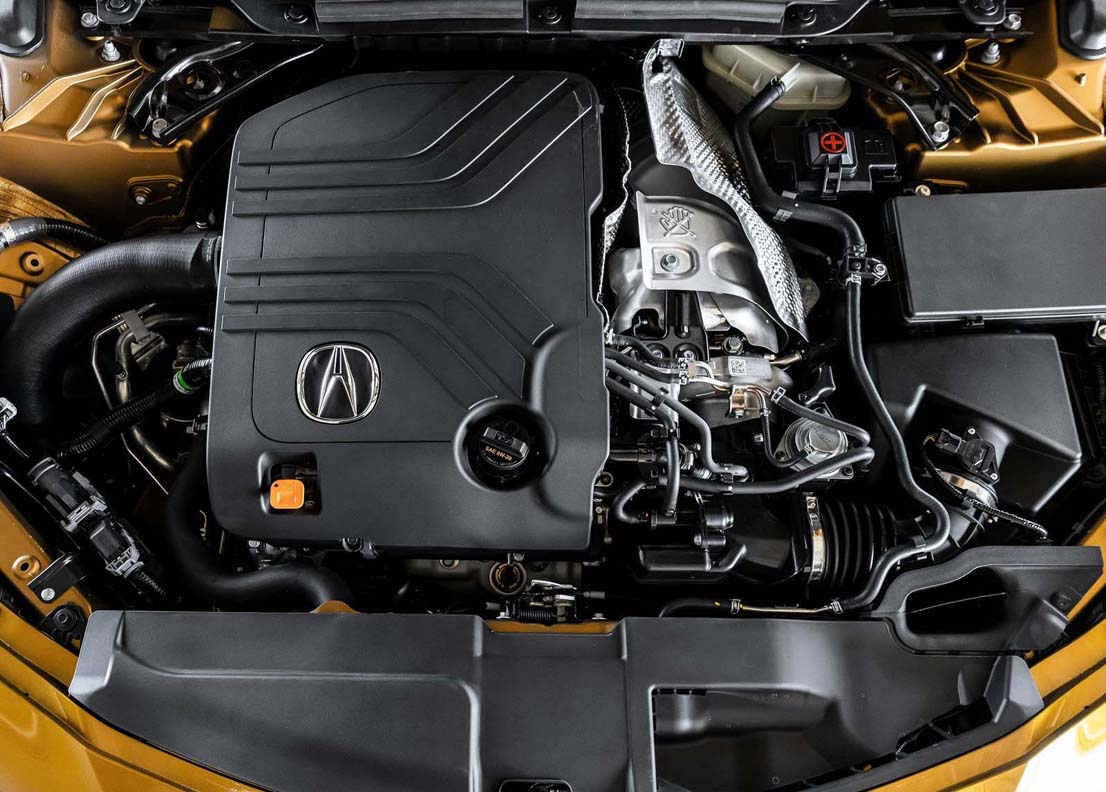
Powertrain
At the heart of the 2021 Acura TLX Type S is the Type S Turbo V6, an all-new, 24-valve, DOHC 3.0-liter V6 engine with direct-injection and a single twin-scroll turbocharger. Exclusive to Type S models, the engine was developed by some of the company’s most experienced powertrain engineers, including members of the team that developed the Civic Type R engine and the NSX’s bespoke twin-turbocharged V6 hybrid power unit. As a result, the engine benefits from multiple disciplines and learnings from the current 3.5-liter V6, the turbocharged 2.0-liter four-cylinder and the NSX engine itself to produce 355 horsepower and 354 lb.-ft. of torque.
Reengineered to match the additional torque of the new engine, the 10-speed automatic transmission is now stronger and shifts more quickly. Also optimized for the performance demands of the Type S customer, the fourth generation of Acura’s Super Handling All-Wheel Drive™ with torque vectoring is standard.
Type S Turbo V6
An all-new, 24-valve, DOHC 3.0-liter with direct-injection and a single twin-scroll turbocharger developing up to 15.1 psi of boost, the Type S Turbo V6 features all-aluminum construction and compact dimensions. Its block is unique, sharing only bore spacing and a 60-degree architecture with the 3.5-liter V6 found in the MDX. Significant differences between the two include the 3.0-liter’s 6-bolt sintered main caps for increased crank rigidity and durability, and a fully square 86 mm bore and stroke.
Numerous engineering steps were taken to ensure the new engine’s compact size and low profile. This includes the placement of the turbocharger adjacent to the engine above the transmission and the use of low-profile cylinder heads. Fully assembled, the engine is 8 mm shorter than the naturally aspirated 3.5-liter V6. The Type S Turbo V6 is also the same width as the 3.5-liter V6.
The newly developed twin-scroll turbo features independent internal paths for the rear and front cylinder banks to feed exhaust pressure to the turbine, which helps improve turbo response. The engine’s rear bank of cylinders pressurize the smaller diameter scroll to rotate the smaller diameter part of the turbine, while the front bank feed the larger diameter scroll and turbine wheel. As a result, the engine’s peak torque of 354 lb.-ft. is available starting from an exceptionally low 1,400 rpm.
To improve emissions, the turbo system’s heat management has been optimized to quickly activate the catalytic converter. This includes the use of a double pipe from the exhaust manifolds to the turbo itself that includes external bellows to dissipate extra heat. The catalytic converter connects to the exhaust outlet of the turbo using a V-band, which further reduces heat mass entering the catalyst. This is the first time this thermal management technology has been used in the Acura engine. To better manage overall engine temperatures an additional sub-radiator is employed and the open-surface Diamond Pentagon grille increases airflow to the engine compartment by 10 percent.
To meet the demands of extreme performance and durability, the Type S Turbo V6 also features a robust rotating assembly. Like the twin-turbo V6 in the NSX, it employs a high-strength forged steel crankshaft, while its connecting rods use the forged steel construction from Acura’s 2.0-liter turbocharged 4-cylinder.
Unique to the Type S Turbo V6 is the design of its pistons. The top piston ring carrier is a high-density Ni-resist cast iron, which features better wear characteristics and better sealing, helping to reduce emissions.
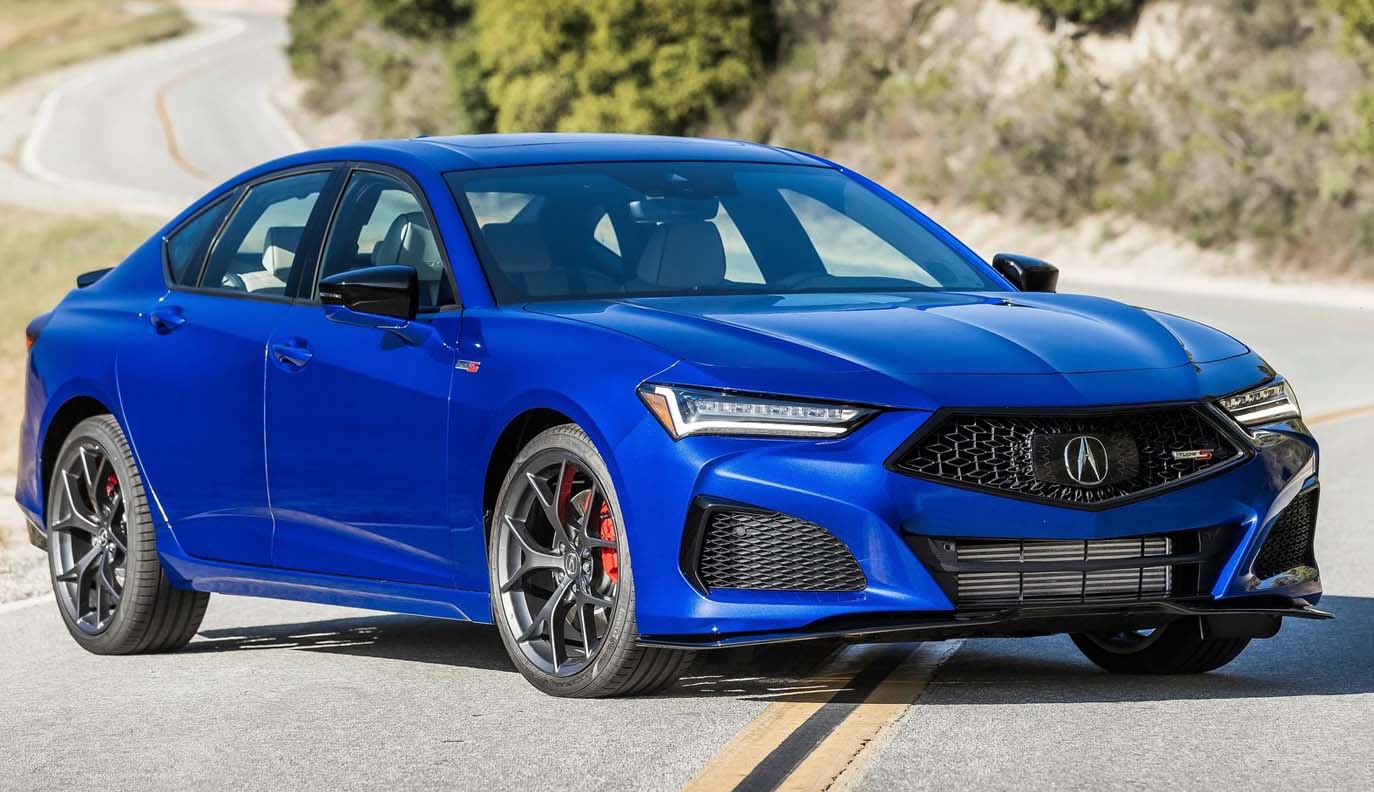
Low-Profile Double Overhead Cam Cylinder Heads
Multiple solutions have been employed to fit the Type S Turbo V6 under the low hood line of the TLX. To help achieve the engine’s low-profile form, engineers did away with separate cam bearing caps and instead incorporated the caps directly into the valve cover itself. Not only does this help lower the engine’s height, it also reduces the number of parts.
Variable Cylinder Management™
A primary goal of the new Type S Turbo V6 was to implement Variable Cylinder Management™ (VCM™) to improve fuel efficiency and reduce emissions. Simultaneously achieving this goal with the twin-cam, low-profile heads and turbocharged engine presented unique challenges, resulting in an all-new mechanism.
VCM™ operates the engine with three cylinders in a wide range of situations to maximize fuel efficiency and lower emissions, switching seamlessly to six-cylinder operation when more power is needed. In order to prevent pumping losses, the engine computer closes the valves on the inactive cylinders. On the SOHC 3.5-liter engine, this is accomplished by using VTEC®, which locks the rocker arms activating the valves together to prevent the valves from opening when VCM™ is active.
Due to the low-profile of the new DOHC cylinder heads, this arrangement has been replaced with a more compact rocker arm and hydraulic lash adjuster design. When all six cylinders are in use, a pin in the valve lifter assembly is held in place with oil pressure. When VCM™ is activated under light cruise and when off-boost, the engine’s Electronic Control Unit (ECU) drops the oil pressure, allowing the pin to slide out of the lifter, creating a gap that prevents the valve from opening. When the ECU determines all six cylinders are needed, the system re-pressurizes the oil, sliding the pin back in place and reactivating the valves for full power, all before the turbo can create boost.
Active Vibration Control
To maintain smooth operation when Variable Cylinder Management™ is engaged, new engine mounts and Active Vibration Control are used. Unique to the Type S Turbo V6, AVC uses sensors to detect and cancel out vibrations from the engine, and for the first time also help to cancel out vibration from the chassis as well, making use of VCM™ nearly imperceptible by the vehicle’s occupants. In addition, careful tuning of the AVC is used in the different Integrated Dynamic Modes to create a quieter or sportier engine sound.
Active Exhaust
Acura TLX Type S also features an Active Exhaust system, adapted from the NSX. The Active Exhaust opens a butterfly valve in each muffler to let more of the V6 engine’s natural sound enter the cabin for a distinct auditory experience. When fully opened, the exhaust sound is 5-7 decibels louder, as measured from about 20 inches (500mm) 45-degrees laterally from the exhaust tip. In addition, the exhaust system valve is used to vary the exhaust system flow rate, which helps reduce possible “booming” from the exhaust system, as well as helping with the gear-shift “pop” sound.
The Active Exhaust system operation is dependent on the selected Integrated Dynamics System mode. In Comfort mode, the valves are closed at startup and at idle, and remain closed until 4,000 rpm. In Normal mode the engine starts and idles with the valves open for a more exciting startup experience. Once the transmission is shifted into gear, the valves close and remain closed until 4,000 rpm. In Sport mode, the valves are fully open at idle and at launch but close during cruising, and in Sport+ the valves are open at all times.
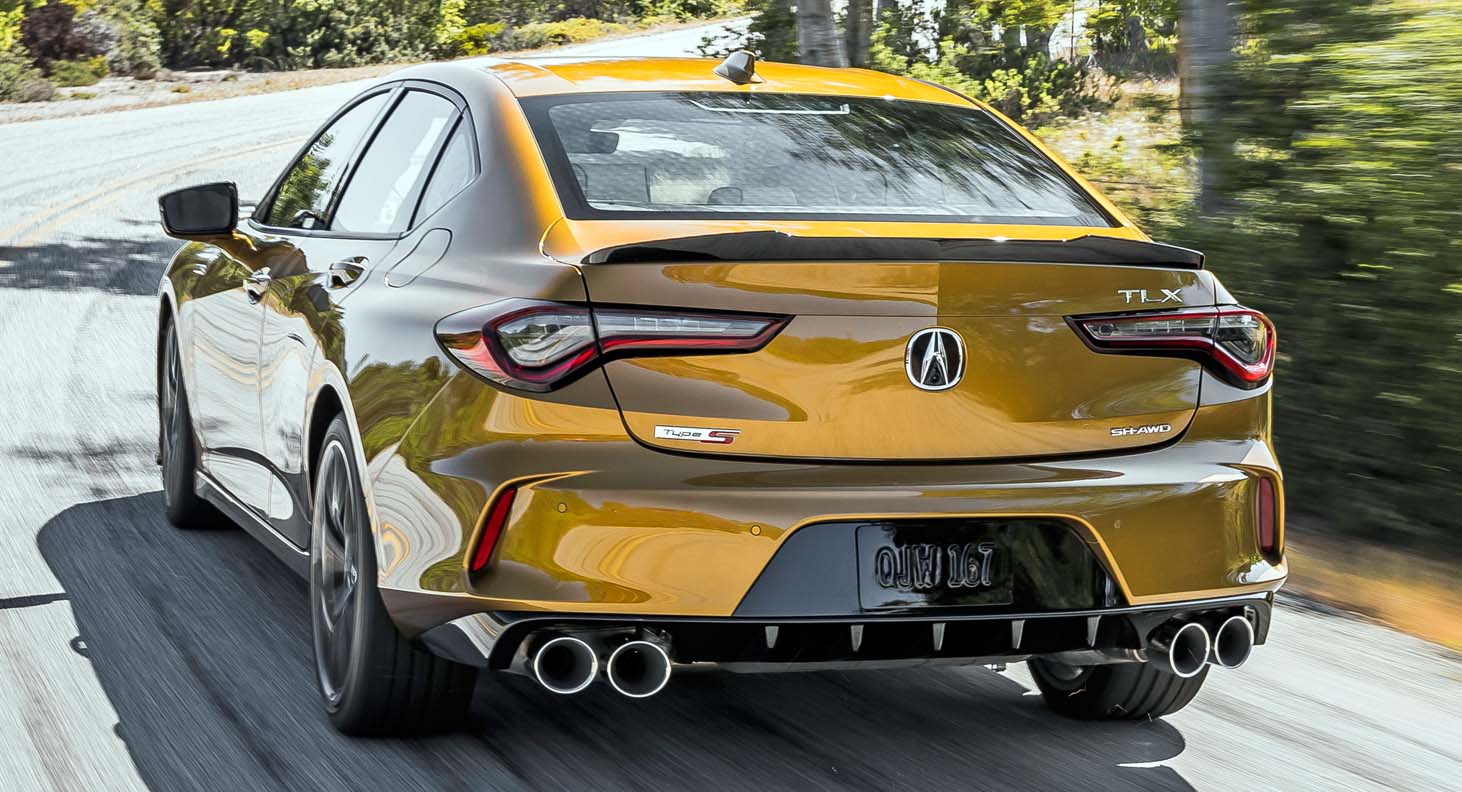
Active Noise Cancellation™
Active Noise Cancellation™ (ANC) is applied to reduce unwanted sound, especially during VCM™ cylinder deactivation mode. The ANC system also incorporates Active Sound Control (ASC), which enhances the vehicle’s natural engine, intake and exhaust sound inside the cabin using the vehicle’s speakers.
High-Performance 10-Speed Automatic Transmission
The new engine is exclusively paired with an enhanced version of Acura’s 10-speed automatic that has been updated to handle the considerable torque and power output of the Type S Turbo V6. Updated internal components include a new torque converter, stronger internal gears, improved internal clutches, and a Type S-exclusive transmission cooler mounted in front of the radiator designed to keep the transmission operating temperatures constant even at the vehicle’s 155-mph top speed.
Drivers can choose fully automatic operation or use steering-wheel mounted paddles to manually shift for themselves. When using the paddles, the transmission uses Type S-exclusive programming for 40-percent quicker downshifts. In Sport+ mode, the transmission also upshifts 30 percent faster by using a brief fuel cut during the gearchange.
Internally, the 10-speed automatic underwent significant changes. The P1 and P3 pinion gears both use stronger materials, and the P2, P3, intermediate shaft, and P1 ring hub all benefit from a fine-particle peen (FPP) process. Similar to more conventional shot peening, FPP uses a much smaller media that increases surface hardness and wear resistance, but with an ultra-smooth finish that is ideal for the close-tolerance areas inside a transmission. Additional strengthening measures include carbon nitriding of the two-way clutch hub, and a paproslide solid lubricant coating on the P2 sun gear. Additionally, a new torque converter uses a high torque-compliant damper to accommodate the increased torque output of the new engine, and the transmission valve body is also modified for the high-pressure usage needed for lock up control on the high-torque engine.
Super Handling All-Wheel Drive System™ (SH-AWD®)
The Acura TLX Type S comes standard with the fourth generation of Acura’s acclaimed Super Handling All-Wheel Drive™ (SH-AWD®), making it the first Type S ever with SH-AWD®. The system progressively distributes optimum torque not only between the front and rear axles, but also between the left and right rear wheels for more precise and exhilarating handling response across a wide variety of road conditions.
Introduced in the 2019 RDX, the rear differential in the fourth-generation SH-AWD® system has been enhanced specifically in anticipation for the new Type S Turbo V6. Compared to the third-generation system, maximum rear axle torque capacity has been increased by 40 percent, and the rear wheels also receive torque 30 percent faster in normal conditions. Up to 70 percent of torque can be sent to the rear axle, and 100 percent of that torque can be distributed to either the left or right rear wheel.
This is achieved by the adoption of a shorter hydraulic circuit and a higher-torque electric motor that drives the rear differential’s twin hydraulic pumps. The hydraulic circuit was also optimized for more consistent response time at the left and right rear wheels.
Depending on throttle angle and vehicle speed, in Sport+ mode the system’s side-to-side bias is increased 40-percent over its response in Sport mode to provide an even sportier rear-wheel drive experience.
When cornering, SH-AWD® distributes more torque to the outside rear wheel, creating a yaw moment to help turn the vehicle through corners, which makes for more accurate turns, reducing understeer and improving controllability. With cornering forces more evenly distributed between front and rear tires, the ability to utilize more torque is increased on wet and dry roads. The system also overdrives the rear axle by 2.9 percent, which amplifies the yaw effect of lateral rear-wheel torque distribution when cornering.
The SH-AWD® system works in cooperation with the Vehicle Stability Assist™ (VSA®) system and Agile Handling Assist® to optimize torque distribution for superior handling and traction utilization. The engine ECU provides information on engine rpm, airflow and transmission gear-ratio selection, while the VSA® ECU provides wheel-speed data. The SH-AWD® ECU also monitors steering angle, lateral g-forces, vehicle yaw rate and electrohydraulic clutch engagement for the right and left rear axle shafts. Drive torque is calculated by the ECU, and then the acceleration, wheel spin, lateral G-force and steering angle are used to determine the front-to-rear torque distribution and the torque split between right and left rear wheels.
Based on the Integrated Dynamics System mode selected, one of three different SH-AWD® maps is used. Normal and Comfort modes have SH-AWD® programming aimed at all-around driving, while Sport mode has a more aggressive SH-AWD® programming that targets performance driving. Sport+ uses an even more aggressive torque management programming focused on maximizing cornering agility and handling performance.
The Acura TLX Type S SH-AWD® is a full-time all-wheel-drive system with a torque-transfer unit bolted directly to the front-mounted transaxle. The torque-transfer unit receives torque through a spline connection that is part of the front differential housing. A set of helical gear shafts and a hypoid gear set within the torque-transfer unit sends power to the propeller shaft, which in turn transfers power to the rear differential.
The lightweight SH-AWD® rear differential utilizes an electric motor that powers a pair of hydraulic pumps – one for each clutch pack. A pair of linear solenoids controlled by the Electronic Control Unit (ECU) selectively sends pressure to the clutch packs, which in turn control the amount of power sent to each rear wheel increasing cornering grip and line traceability.
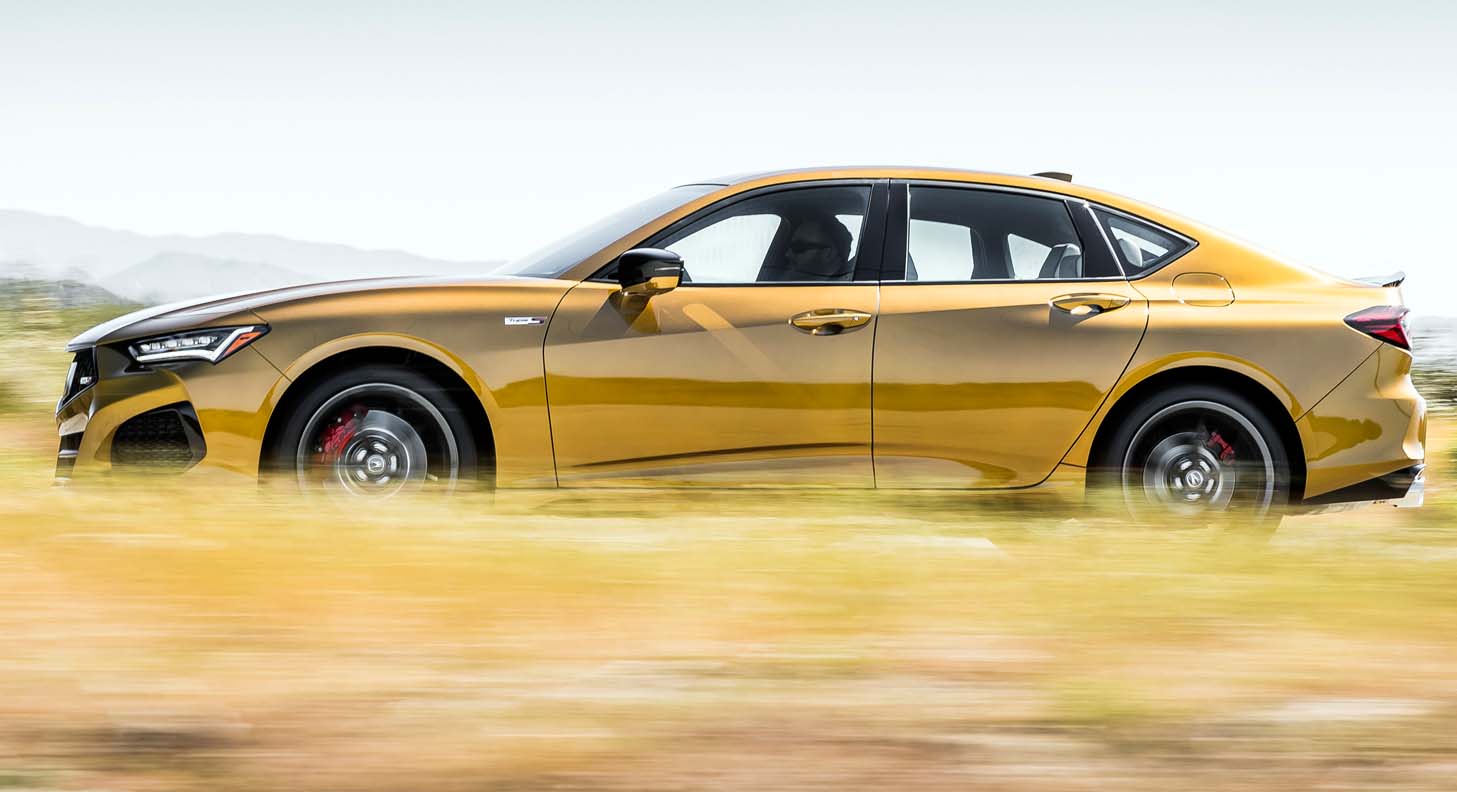
Body & Chassis
When introduced in 2020, the bespoke chassis of the second-generation TLX made it the stiffest sedan ever produced by Acura. For the TLX Type S, the exclusive platform has been further tuned for additional strength, refinement and response. Changes include additional structural reinforcement of the body, updates to the double wishbone front and multilink independent rear suspension, fine-tuning of the steering and adaptive dampers, more powerful brakes, and standard 20-inch wheels and tires.
Structural Enhancements
For Type S duty, the TLX body has been further reinforced with additional bracing, resulting in an additional 13-percent improvement in chassis rigidity. This enhanced rigidity helps improve handling and chassis responsiveness, giving the Acura TLX Type S sharper reflexes.
Specific areas of reinforcement start in the front, with additional structural braces linking the shock towers, and triangulating to the firewall to create a stiffer “box” for the engine and transmission. In the rear, steel reinforcements behind the rear seats create an “A-Brace”, stiffening the rear bulkhead and significantly improving rear tire contact patch under aggressive cornering. Additional structural enhancements include an extra mid-floor crossmember and stiffer rear wheel arches. Total curb weight for the TLX Type S is 4,221 pounds, or 4,200 pounds with the available lightweight wheels.
Double-Wishbone Front Suspension
The TLX’s front suspension uses two wishbone-shaped control arms, in place of the more common MacPherson strut setup in many competing sport sedans including the BMW M340i, to deliver more precise control of wheel camber, caster and toe angles, and to maximize tire-to-ground contact for exceptional handling precision and cornering grip. Due to its inherent performance-enhancing attributes, double wishbone suspension underpins the second-generation NSX supercar and was a staple of Acura performance products of the past, including the Legend (1986-1995), Integra (1990-2001), TL and TL Type S (1996-2014), and first-generation NSX (1991-2005).
To further improve handling and driver excitement, the front double-wishbone suspension and rear multilink suspension of the Acura TLX Type S have been updated to fully utilize the sedan’s reinforced chassis. Engineers added 40-percent stiffer front springs, and a slightly thicker front stabilizer bar (29.5 mm to 30 mm) that is 9-percent stiffer. In the rear, the spring rates are unchanged from TLX to help preserve a comfortable ride, and the thickness of the stabilizer bar has increased from 20.5 mm to 22.5 mm for 31-percent additional roll stiffness.
Adaptive Damper System
TLX Type S uses Acura’s Adaptive Damper System, which continuously adjusts damping force based on sensor inputs. The dampers are also tied into the Integrated Dynamics System, providing three unique damping curves set to the driving mode (Comfort, Normal, Sport). For Type S, the dampers use exclusive valve rates with 4-percent more damping capability in the front and 9-percent more in the rear, which give the car a sportier feel with more feedback in all modes.
In addition, thicker gussets connect the side frame and the damper housings, to help support the damper housing from the increased cornering loads from the sticker tires worn by the Type S.
Belt-driven Electric Power Steering (EPS) system
The belt-driven Electric Power Steering (EPS) system in TLX Type S uses a unique variable gear ratio tuned for a more responsive feel than the standard TLX, particularly in initial response. This gives Acura TLX Type S a much more agile feel at low- to mid-range speeds.
Electro Servo Braking System
First developed for the second-generation NSX, Acura’s electric-servo system allows engineers to finely tune the brake pedal force in the TLX Type S and electronically control the brake pressure to optimize the vehicle’s performance driving characteristics, while giving Acura TLX Type S a brake stroke that’s very similar to NSX.
Brembo® Front Brakes
Braking performance is further improved with the addition of larger, more powerful Brembo® front brakes. The new Brembo® four-piston front calipers grip rotors that are 14.3-inches in diameter (+1.3 inches) and 1.2 inches thick, for an 11-percent increase in thermal mass, for improved resistance to fade in the kinds of repeated hard use demanded of brakes in a performance sedan. Stopping distances from 60 mph are improved by 13 percent.
The rear brake calipers are painted in the same red as the front, and the brake rotors in both front and rear are treated with Ferritic Nitrocarburizing (FNC) coating for improved corrosion resistance.
Type S Integrated Dynamics System
With its standard Integrated Dynamics System, the TLX Type S offers drivers an expanded ability to customize their driving experience. In addition to Normal, Comfort, Sport and Individual modes, Type S adds an exclusive Sport+ mode.
Sport+ is activated by turning the Dynamic Mode dial all the way to the right and holding it for one second. When activated, Sport+ further sharpens throttle response, quickens transmission upshifts by 30-percent, and enables an even more aggressive SH-AWD® profile, while retaining the aggressive damper settings and higher steering effort from Sport mode. Depending on throttle angle and vehicle speed, in Sport+ mode side-to-side bias of the SH-AWD® system is increased 40-percent over its response in Sport mode to provide an even sportier rear-wheel drive experience.
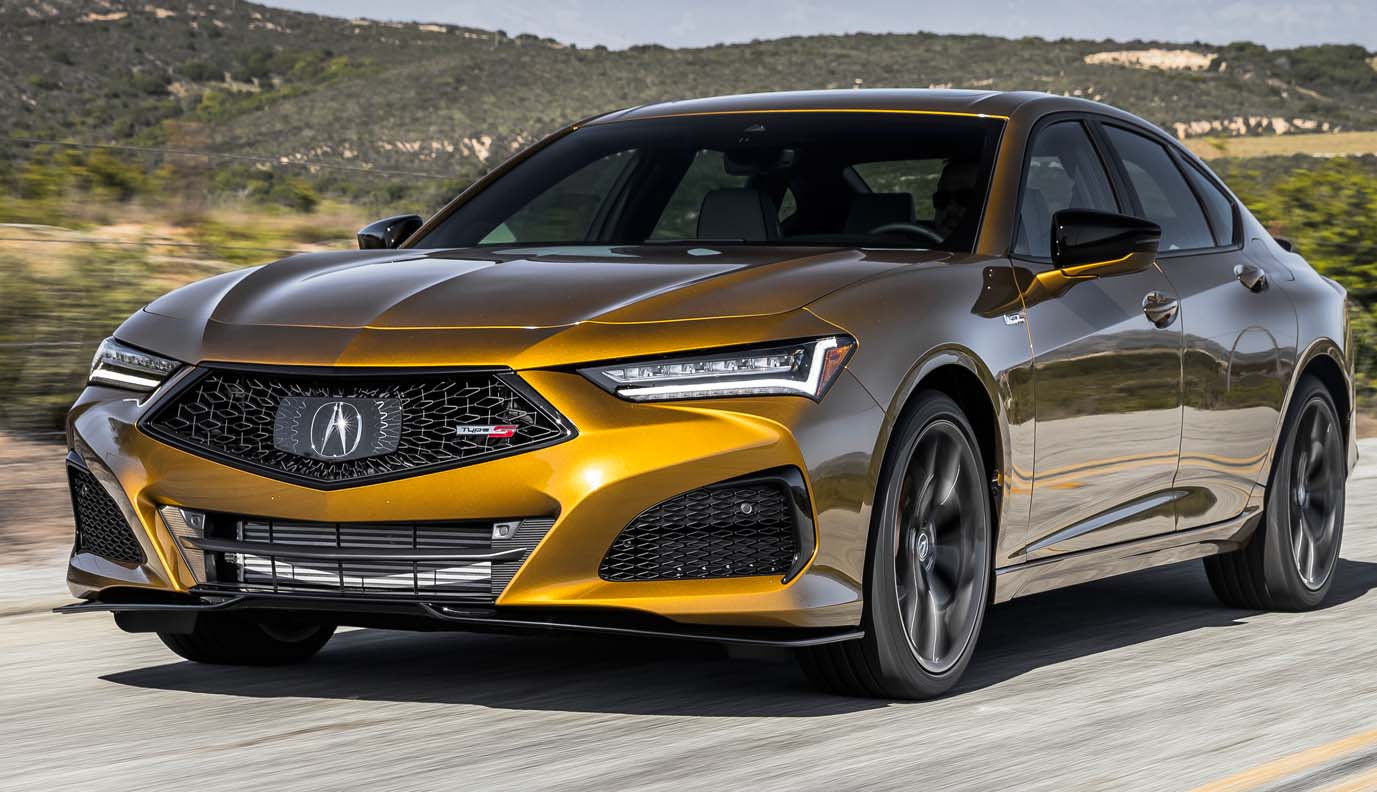
Type S Wheels & Tires
TLX Type S comes with a choice of two different wheels and tires. Standard is a 20×9.0 shark-gray finished multi-spoke design reminiscent of the wheels on the Type S Concept. The standard tire option is a 255/35R20 Pirelli Cinturano P7 all-season performance tire.
Available as a factory installed option is a lightweight split five-spoke wheel inspired by the Acura NSX. The four lightweight wheels reduce unsprung weight by 5.78 pounds each and are paired with 255/35R20 Pirelli P Zero Summer tires, each of which weigh 0.44 pounds more than the standard all-season tires. The total reduction of about 21.3 pounds in unsprung weight has an outsized impact versus weight savings elsewhere in the car, with the lower rotational inertia helping to improve agility and roadholding, while simultaneously benefitting ride comfort. The Pirelli P Zero Summer tire was specifically developed for the TLX Type S. Acura developed all aspects of the tire with Pirelli to match development targets, including performance on the racetrack.
Exterior & Interior
As with the entire TLX lineup, the styling of the 2021 Acura TLX is heavily derived from the Type S Concept from 2019. The Type S is distinct from any angle with unique touches such as an aggressive front splitter, large quad-exhaust outlets and a purposeful rear diffuser.
Exterior
Numerous Type S signatures distinguish the TLX performance variant, including an exclusive open-surface Diamond Pentagon grille increasing engine airflow by 10-percent, splitter on the front fascia, in addition to gloss black grille and matte black window surrounds. Type S also features headlights with a blackout treatment, better matching the dark theme.
In the rear, Type S adds a more pronounced gloss-black diffuser to the bottom of the rear fascia, and large quad-exhaust finishers which incorporate the Active Exhaust system. Type S badges are found on the grille, front fenders and trunk lid. Both 20-inch wheel options showcase the bright red brake calipers in front and rear. Similar to the front end, the taillights have a dark finish.
Additionally, Type S is available with carbon fiber decklid lip spoiler, carbon-fiber diffuser, and lower side sills as dealer-installed accessories to even more closely match the Type S Concept.
Acura TLX Type S will be available in six exterior colors: Modern Steel Metallic, Majestic Black Pearl, Platinum White Pearl, Performance Red Pearl, Apex Blue Pearl and a Type S exclusive Tiger Eye Pearl.
Interior
Inside the cabin, exclusive Type S features include 16-way power adjustable front seats with power adjustable bolsters, contrasting stitching and piping as well as the Type S logo embossed on the head restraint. Three interior colors are available: Ebony, Red, and the Type S-exclusive Orchid, all with Black Ultrasuede® inserts. Type S also features an NSX-inspired flat-bottom steering wheel with a prominent Type S logo, authentic aluminum trim on the doors and dash, Type S door sill trim and French stitching on the dash top and door armrests.
The critically acclaimed and award-winning Acura ELS STUDIO 3D® 17-speaker premium audio system is standard, along with Acura’s innovative and driver-oriented True Touchpad Interface™, with its “Absolute Positioning” console-mounted touchpad and high-mounted 10.2-inch HD center display.
Design, Development and Manufacturing
Design, engineering and development of the 2021 Acura TLX Type S was conducted primarily in America, with styling led by Acura Design in Torrance, Calif., and full platform development led by engineers at Honda Development & Manufacturing of America, LLC, the company’s development center in Raymond, Ohio. Engineering development of the new 3.0-liter turbocharged V6 was led by the company’s R&D center in Tochigi, Japan.
The new Acura TLX Type S is manufactured exclusively at the company’s Marysville, Ohio, plant using domestic and globally sourced parts, with the company’s Anna, Ohio, engine plant serving as the exclusive global source for the 3.0-liter turbocharged engine. This same facility builds all Acura engines sold in North America including the twin-turbo V6 used in the NSX. The 10-speed automatic transmission is manufactured at the company’s Tallapoosa, Georgia, plant, and the SH-AWD® system’s front power takeoff unit and rear differential is manufactured in the company’s Russells Point, Ohio, plant.
